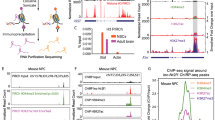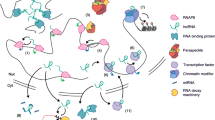Abstract
Long noncoding RNAs (lncRNAs) are a new class of noncoding RNAs that have been extensively studied in the recent past as a regulator of gene expression, including modulation of epigenetic regulation. The lncRNAs class encompasses a number of subclasses, classified based on their genomic loci and relation to protein-coding genes. Functional differences between subclasses have been increasingly studied in the recent years, though the regulation of expression and biogenesis of lncRNAs have been poorly studied. The availability of genome-scale datasets of epigenetic marks has motivated us to understand the patterns and processes of epigenetic regulation of lncRNAs. Here we analysed the occurrence of expressive and repressive histone marks at the transcription start site (TSS) of lncRNAs and their subclasses, and compared these profiles with that of the protein-coding regions. We observe distinct differences in the density of histone marks across the TSS of a few lncRNA subclasses. The sense-intronic lncRNA subclass showed a paucity for mapped histone marks across the TSS which were significantly different than all the lncRNAs and protein-coding genes in most cases. Similar pattern was also observed for the density of transcription factor binding sites (TFBS). These observations were generally consistent across cell and tissue types. The differences in density across the promoter were significantly associated with the expression level of the genes, but the differences between the densities across long noncoding and protein-coding gene promoters were consistent irrespective of the expression levels. Apart from suggesting general differences in epigenetic regulatory marks across long noncoding RNA promoters, our analysis suggests a possible alternative mechanism of regulation and/or biogenesis of sense-intronic lncRNAs.




Similar content being viewed by others
References
Bernstein B. E., Birney E., Dunham I., Green E. D., Gunter C. and Snyder M. 2012 An integrated encyclopedia of DNA elements in the human genome. Nature 489, 57–74.
Bhartiya D., Kapoor S., Jalali S., Sati S., Kaushik K. et al. 2012 Conceptual approaches for lncRNA drug discovery and future strategies. Expert. Opin. Drug Discov. 7, 503–513.
Cedar H. and Bergman Y. 2009 Linking DNA methylation and histone modification: patterns and paradigms. Nat. Rev. Genet. 10, 295–304.
Clark M. B. and Mattick J. S. 2011 Long non-coding RNAs in cell biology. Semin. Cell. Dev. Biol. 22, 366–376.
Dhami P., Saffrey P., Bruce A. W., Dillon S. C., Chiang K. et al. 2010 Complex exon-intron marking by histone modifications is not determined solely by nucleosome distribution. PLoS One 5, e12339.
Dieci G., Fiorino G., Castelnuovo M., Teichmann M. and Pagano A. 2007 The expanding RNA polymerase III transcriptome. Trends Genet. 23, 614–622.
Dinger M. E., Amaral P. P., Mercer T. R., Pang K. C., Bruce S. J. et al. 2008 Long non-coding RNAs in mouse embryonic stem cell pluripotency and differentiation. Genome Res. 18, 1433–1445.
Fasanaro P., D’Alessandra Y., Magenta A., Pompilio G. and Capogrossi M. C. 2013 MicroRNAs: promising biomarkers and therapeutic targets of acute myocardial ischemia. Curr. Vas. Pharmacol. (in press).
Guttman M. and Rinn J. L. 2012 Modular regulatory principles of large non-coding RNAs. Nature 482, 339–346.
Hahn M. A., Wu X., Li A. X., Hahn T. and Pfeifer G. P. 2011 Relationship between gene body DNA methylation and intragenic H3K9me3 and H3K36me3 chromatin marks. PLoS One 6, e18844.
He L. and Hannon G. J. 2004 MicroRNAs: small RNAs with a big role in gene regulation. Nat. Rev. Genet. 5, 522–531.
Hurd P. J. and Nelson C. J. 2009 Advantages of next-generation sequencing versus the microarray in epigenetic research. Brief Funct. Genomic Proteomic 8, 174–183.
Ji P., Diederichs S., Wang W., Boing S., Metzger R. et al. 2003 MALAT-1, a novel non-coding RNA, and thymosin beta4 predict metastasis and survival in early-stage non-small cell lung cancer. Oncogene 22, 8031–8041.
Kaushik K., Leonard V. E., Kv S., Lalwani M. K., Jalali S. et al. 2013 Dynamic expression of long non-coding RNAs (lncRNAs) in adult zebrafish. PLoS One 8, e83616.
Kolasinska-Zwierz P., Down T., Latorre I., Liu T., Liu X. S. and Ahringer J. 2009 Differential chromatin marking of introns and expressed exons by H3K36me3. Nat. Genet. 41, 376–381.
Liao Q., Liu C., Yuan X., Kang S., Miao R. et al. 2011 Large-scale prediction of long non-coding RNA functions in a coding-non-coding gene co-expression network. Nucleic Acids Res. 39, 3864–3878.
Mattick J. S., Amaral P. P., Dinger M. E., Mercer T. R. and Mehler M. F. 2009 RNA regulation of epigenetic processes. BioEssays 31, 51–59.
Mercer T. R., Dinger M. E. and Mattick J. S. 2009 Long non-coding RNAs: insights into functions. Nat. Rev. Genet. 10, 155–159.
Mercer T. R., Dinger M. E., Sunkin S. M., Mehler M. F. and Mattick J. S. 2008 Specific expression of long non-coding RNAs in the mouse brain. Proc. Natl. Acad. Sci. USA 105, 716–721.
Morozova O., Hirst M. and Marra M. A. 2009 Applications of new sequencing technologies for transcriptome analysis. Annu. Rev. Genomics Hum. Genet. 10, 135–151.
Nagano T. and Fraser P. 2011 No-nonsense functions for long non-coding RNAs. Cell 145, 178–181.
Pasmant E., Sabbagh A., Vidaud M. and Bieche I. 2011 ANRIL, a long, non-coding RNA, is an unexpected major hotspot in GWAS. FASEB J. 25, 444–448.
Ponting C. P., Oliver P. L. and Reik W. 2009 Evolution and functions of long non-coding RNAs. Cell 136, 629–641.
Rajpathak S. N., Vellarikkal S. K., Patowary A., Scaria V., Sivasubbu S. and Deobagkar D. D. 2014 Human 45,X fibroblast transcriptome reveals distinct differentially expressed genes including long non-coding RNAs potentially associated with the pathophysiology of turner syndrome. PLoS One 9, e100076.
Rinn J. L., Kertesz M., Wang J. K., Squazzo S. L., Xu X. et al. 2007 Functional demarcation of active and silent chromatin domains in human HOX loci by non-coding RNAs. Cell 129, 1311–1323.
Sati S., Ghosh S., Jain V., Scaria V. and Sengupta S. 2012a Genome-wide analysis reveals distinct patterns of epigenetic features in long non-coding RNA loci. Nucleic Acids Res. 40, 10018–10031.
Sati S., Tanwar V. S., Kumar K. A., Patowary A., Jain V. et al. 2012b High resolution methylome map of rat indicates role of intragenic DNA methylation in identification of coding region. PLoS One 7, e31621.
Saxena A. and Carninci P. 2011 Long non-coding RNA modifies chromatin: epigenetic silencing by long non-coding RNAs. BioEssays 33, 830–839.
Tsai M. C., Manor O., Wan Y., Mosammaparast N., Wang J. K. et al. 2010 Long non-coding RNA as modular scaffold of histone modification complexes. Science 329, 689–693.
Wang K. C. and Chang H. Y. 2011 Molecular mechanisms of long non-coding RNAs. Mol. Cell. 43, 904–914.
Wapinski O. and Chang H. Y. 2011 Long non-coding RNAs and human disease. Trends Cell Biol. 21, 354–361.
Yap K. L., Li S., Munoz-Cabello A. M., Raguz S., Zeng L. et al. 2010 Molecular interplay of the non-coding RNA ANRIL and methylated histone H3 lysine 27 by polycomb CBX7 in transcriptional silencing of INK4a. Mol. Cell 38, 662–674.
Zhang Z., Pang A. W., and Gerstein M. 2007 Comparative analysis of genome tiling array data reveals many novel primate-specific functional RNAs in human. BMC Evol. Biol. 7, suppl 1, S14.
Acknowledgements
The authors acknowledge the discussions with Dr. Sheetal Gandotra which considerably improved thought process and content of the manuscript. SSa and SG acknowledges a Senior Research Fellowship from the Council of Scientific and Industrial Research, India. This work was funded by the Council of Scientific and Industrial Research, India through project GENCODE-C (BSC0123). We acknowledge the NIH Roadmap to Epigenomics Consortium members for producing the data used in our analysis procedures. We are thankful to NIH Roadmap, Epigenomics Consortium for maintaining an open access to the datasets deposited in NIH Roadmap Epigenomics Project Data Listings at http://nihroadmap.nih.gov/epigenomics/.
Author information
Authors and Affiliations
Corresponding authors
Additional information
[Ghosh S., Sati S., Sengupta S. and Scaria V. 2015 Distinct patterns of epigenetic marks and transcription factor binding sites across promoters of sense-intronic long noncoding RNAs. J. Genet. 94, xx–xx]
Sourav Ghosh and Satish Sati contributed equally to this work.
VS and SSe designed the analysis pipeline and coordinated the study. VS and SSe wrote the manuscript. Bioinformatics analysis was carried out by VS, SG and SSe.
Electronic supplementary material
Below is the link to the electronic supplementary material.
Rights and permissions
About this article
Cite this article
GHOSH, S., SATI, S., SENGUPTA, S. et al. Distinct patterns of epigenetic marks and transcription factor binding sites across promoters of sense-intronic long noncoding RNAs. J Genet 94, 17–25 (2015). https://doi.org/10.1007/s12041-015-0484-2
Received:
Revised:
Accepted:
Published:
Issue Date:
DOI: https://doi.org/10.1007/s12041-015-0484-2




